Dulce de leche. Everybody who knows what it is will smile at the name; the curvy big sister of caramel, the tawny siren that lures innocents towards the fridge in the middle of the night, eyes glazed and spoon quivering in hand. The country best known for its dulce de leche is Argentina, where it has been adopted as a national heritage, although many a Uruguayan will argue that the origins and the best examples of this creamy delight are found on their side of the De La Plata River.
In fact, dulce de leche is produced and consumed in various guises throughout the Americas, with names like manjar blanco in Peru to Cajeta in Mexico. No country other than Argentina, however, can claim a three kilogram per capita consumption, and after spending a little bit of time here, it is easy to understand why.
Dulce de leche comes in all shapes and sizes, and can be consumed any time of the day. At breakfast, it is usually baked into a myriad of pastries, and no dessert menu or tea time platter is complete without a solid helping of the stuff. Then, of course, there are endless arrays of alfajores, Argentine cookies that have dulce de leche sandwiched between two spongy biscuits and covered in chocolate — go to snacks for everything from school lunch boxes to business meeting coffee breaks.

A producer of one of the country’s top dulce de leche brands in the country, San Isidro Labrador (owned by the Munchies, a renowned chain of ice-cream stores), took the time to answer a couple of questions about Argentina's favorite indulgence.
What makes dulce de leche specifically Argentine?
One of the primary reasons that Argentine dulce de leche has become famous is the high quality of its dairy cows, and richer milk makes for a superior quality dulce de leche.
What makes San Isidro Labrador dulce de leche different?
We make our dulce de leche from Jersey milk from our own herds; this is a richer, more nutritive milk which makes our product smoother, creamier, healthier and more balanced than most others.
In your opinion, what’s the absolute best thing to do with dulce de leche?
The best has to be the Argentine classic, pancakes with dulce de leche, but it is a product that one can combine with just about everything. No classic Argentine breakfast is complete without toast with butter and dulce de leche.
Tips for making it at home?
For every liter of milk use about 28 ounces of sugar. As the mixture starts to boil, add half a teaspoon of Bicarbonate of soda which helps give color to your dulce de leche. Once it hits boiling point, turn down to low heat stirring constantly with a wooden spoon. It should take a couple of hours of this stirring until it is done. You will know it is done when you let a droplet of dulce de leche fall into a glass of cold water and it doesn’t dissolve, but rather falls to the bottom. To cool it down, place your pot into a bath of cool water, stirring constantly but not scraping the bottom.
Other great brands of dulce de leche to keep an eye out for in the US?
Havanna, Chimbote, and La Salamandra
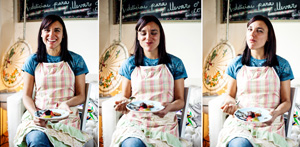
After speaking with San Isidro Labrador, we managed to drag one of the country’s top young dessert chefs, Georgina Manghi (above), out of her temporary retirement. She recently closed her successful Buenos Aires bakery and coffee shop, and is taking a well-deserved break after fifteen years working in kitchens around the world. In her Palermo apartment, now accented by industrial baking pieces and the odd memorial from her coffee shop, she took the time to whip up some of her favorite, easy to make at home dulce de leche recipes for us. They are slightly tweaked versions of very popular desserts here in Buenos Aires, and are easily some of the best dulce de leche incarnations that I have tasted. Fifteen years well spent, I say.
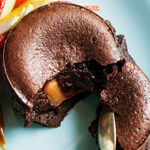
- 5 1/2 ounces semi-bitter chocolate
- 3 ounces of butter
- 4 egg yolks
- 4 egg whites
- 4 tablespoons sugar
- 2 tablespoons flour 0000
- 4 teaspoons bitter cacao
- 10 1/2 ounces dulce de leche
Click here for the full recipe.
Banana and Dulce de Leche Crumble
For the crumble:
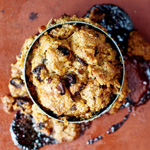 2 ounces butter
2 ounces butter- 6 tablespoons Muscovado sugar
- 1 egg white
- 4 tablespoons self-raising flour
- 2 tablespoons rolled oats
- 2 1/2 ounces chocolate
- 5 1/2 ounces dulce de leche
For the filling:
- 4 bananas
- 4 tablespoons passion fruit juice (can substitute lemon juice)
- 1 tablespoon finely grated ginger
- 5 tablespoons sugar
Click here for the full recipe.
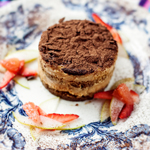
- 1 large cup of strong coffee sweetened to taste.
- 1 packet of vanilla sponge cake
- 14 ounces dulce de leche
- 14 ounces mascarpone
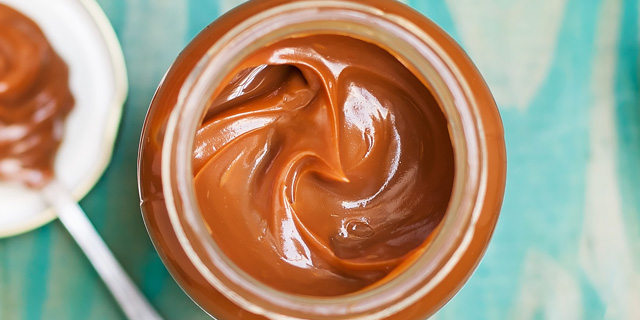

![Making Mealtime Matter with La Familia: Easy Sofrito [Video]](https://thelatinkitchen.com/wp-content/uploads/2015/10/sofrito-shutterstock__0-500x383.jpg)
![Easy Latin Smoothies: Goji Berry Smoothie [Video]](https://thelatinkitchen.com/wp-content/uploads/2015/12/goji_berry-shutterstock_-500x383.jpg)
















![Fun and Fast Recipes: Fiesta Cabbage Salad [Video]](https://thelatinkitchen.com/wp-content/uploads/2015/11/fiesta_cabbage_slaw-shutterstock_-500x383.jpg)









